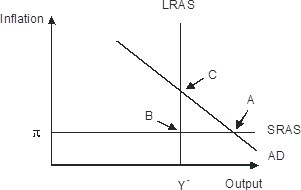The above table has the demand for money schedule
a) If the Fed supplies $1.1 trillion dollars, what is the equilibrium interest rate?
b) Discuss how equilibrium is restored if the interest rate is greater than the equilibrium rate found in part (a).
a) The equilibrium interest rate is 4 percent.
b) If the interest rate is greater than 4 percent, there is an excess supply of money. In this case, to be rid of their "extra" money, people buy bonds. The price of bonds rises and so the interest rate falls until it reaches its equilibrium value, 4 percent. At this interest rate, there is no longer an excess supply of money because the quantity demanded equals the quantity supplied.
You might also like to view...
Freeways in large cities tend to be congested during rush hours to the point where offer little or no advantage over non-freeway routes because
A) drivers generally ignore marginal benefits and costs. B) drivers usually ignore marginal benefits and costs during rush hours. C) no monetary fee is charged for the use of freeways during rush hours. D) not enough freeways have been constructed due to special interests' control of the government. E) people need to get to work and the demand for freeway travel is consequently inelastic during rush hours.
The special demand structure that induces a firm to use a cross-subsidization strategy is:
A. imperfect substitution among products. B. independent demand for products. C. interdependent demand for products. D. perfect substitution among products.
The economy pictured in the figure has a(n) ________ gap with a short-run equilibrium combination of inflation and output indicated by point ________. 
A. recessionary; A B. recessionary; C C. recessionary; B D. expansionary; A
With microfinance, the mechanism of peer lending is a way to avoid the problem of
A. imperfect information. B. a double coincidence of wants. C. capital flight. D. the tragedy of the commons.